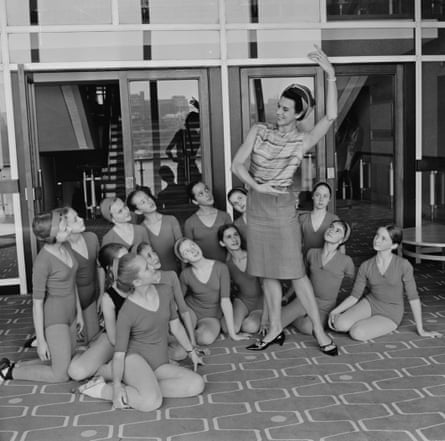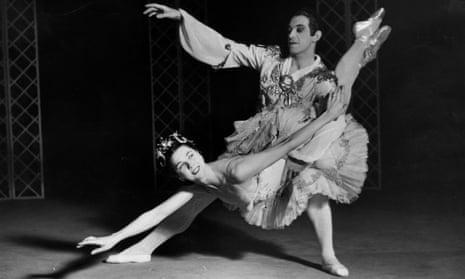In 1941 Beryl Grey, who has died aged 95, was known as Britain’s “baby ballerina” when she joined Sadler’s Wells Ballet at the age of 14, becoming a soloist for the company the following year. She toured Britain as a teenager, dancing nine performances a week, and on her 15th birthday danced Odette-Odile in the complete Swan Lake. At 16 she danced the title role of Giselle.
She remained with Sadler’s Wells as a principal dancer until 1957, by which time it had become the Royal Ballet, and she went on to become the first British ballerina to dance with the Bolshoi in Moscow when, in 1957, Grey danced Swan Lake with Yuri Kondratov. She was also the first British ballerina to perform in communist China (1964), dancing in Swan Lake and Les Sylphides, partnered by Wang Shao Pen, in Peking (Beijing) and Shanghai.
Her warmth came across to her fans both on stage and off. She was a tall, elegant, musical dancer with long legs, confident in what she danced and using her height to great advantage. The Financial Times dance critic Clement Crisp recalled of her dancing that there was “nothing fudged or blurred; nothing uncertain; the choreography understood, the choreographer honoured, and her companion artists respected – but that pleasure in her performance was both ours as the audience and hers as a dancer”.
At the end of her dancing career, Grey was artistic director of London Festival Ballet (now English National Ballet) for 11 years from 1968, restoring the company to international status after a bankruptcy. She not only improved the standard of dancing and opened up the repertory but invited Rudolf Nureyev to choreograph for and dance with her company. Both Nureyev’s Romeo and Juliet and Peter Schaufuss’s La Sylphide won Society of West End Theatre awards.
Born in London, Beryl was the daughter of Annie and “Bob” (Arthur) Groom, a front of house manager for the furniture firm of Gosletts in Old Street. They supported her from the start.

As a child she took weekly dance classes with the leading teacher Madeline Sharp. Beryl received an all-round training in dance, including ballet, Greek, national dances, musical comedy, tap and ballroom. Sharp also arranged for her to have private ballet lessons with the former ballerina and teacher Phyllis Bedells and to study Spanish dance with Elsa Brunelleschi. Her experience of this – and ability to play the castanets – would come into play in the production of Carmen that restored opera to Covent Garden in 1947. Brunelleschi choreographed her solo in the last act, which was the hit of the production.
Aged nine, she won a scholarship to the Vic-Wells Ballet School, where Ninette de Valois changed Beryl’s surname to Grey. After she had spent a year in the school, De Valois wrote that “she has all the gifts that it is possible to bestow on a dancer. Her behaviour is beyond any reproach and she is remarkably unspoilt.”
For a while Grey combined her regular education with dancing in the Vic-Wells corps de ballet. In the early years of the second world war De Valois had a plan that Grey would dance with the company for three months then swap with another young dancer and return to Islington for three months’ schooling. In the event Grey joined Sadler’s Wells in Burnley in August 1941 and never returned to education.

Early creations included two lighthearted works created to show off junior members of the company: Robert Helpmann’s The Birds (1942), in which she played the Nightingale, and De Valois’ lively Promenade (1943). That year she also created the vicious Duessa (in purple satin dress) in Frederick Ashton’s The Quest, an indication of her ability to take on dramatic roles. Indeed, she was unrivalled in this role, “personifying falsehood”, which set her on her way to portraying other deadly figures, including Death in Léonide Massine’s Donald of the Burthens, the Black Queen in de Valois’ Checkmate and, from 1946, the vengeful Myrtha in Giselle.
A particular regret was that she had to turn down the opportunity to play the French Princess in Laurence Olivier’s 1944 film Henry V. Introduced to Olivier by Helpmann, she was invited to do a screen test, but when De Valois heard, she put a stop to it.
Grey enjoyed creating ballets with Helpmann and Massine and welcomed the opportunity to work with the influential choreographer George Balanchine. Staging Ballet Imperial in 1950, he chose her for the second ballerina. Balanchine liked to work with tall dancers and Grey took to his precise choreography with ease, revelling in the challenging jumps and beats.
Famously Grey danced as the Lilac Fairy, a role she imbued with charm, radiance and authority, in the Oliver Messel-designed production of The Sleeping Beauty both when it reopened the Royal Opera House after the war in 1946 and at the Sadler’s Wells company’s debut at the Metropolitan Opera House, New York, the same year.
She became associated with the virtuoso role of the lady who abandons the haute monde for the true love of a clown in John Cranko’s The Lady and the Fool and took a number of roles created for her by Ashton: she was one of three Echos in The Fairy Queen (1946) and two years later Winter in Cinderella. Grey brought a crispness and seasonal sparkle to her solo, although she found the costume designed by Jean Denis Malclès, with prickly icicles hanging from her arms, extremely uncomfortable to move in.

Ashton cast four couples in lead roles for Sylvia, and Grey was paired with Philip Chatfield. It was the start of a memorable partnership. In 1956 Grey created one of the variations in Birthday Offering, for the 25th anniversary of the company about to be designated The Royal Ballet.
Grey was one of six ballerinas supporting Margot Fonteyn and Michael Somes, each with a solo in the academic style of the French choreographer Marius Petipa, which showed their individual strengths. But the work also emphasised the challenge that Grey and the others faced – their way to the top of the company was blocked by the prima ballerina, Fonteyn. All had to find their own ways to complete their dancing careers. For Grey the decision was to turn freelance the following year and control her own future.
Grey found a sympathetic teacher in Audrey de Vos, who built up her confidence. De Vos took a holistic approach to teaching and her warm-ups included natural movements and floor exercises. De Vos became mentor to Grey and helped her plan her independent tours, choreographing dances for the one she undertook in 1957 with Oleg Briansky, including the romantic solo Reverie, which was also filmed by the BBC in 1963.
Several of Grey’s performances were recorded, and she danced Odile in the stereoscopic Black Swan film (1952) created for the Festival Gardens, Battersea. Her last performance came in an extract from Les Sylphides at a gala attended by Princess Margaret in 1965.
In her books Red Curtain Up (1958) and Through the Bamboo Curtain (1965) Grey recorded her tours to the Soviet Union and China, but she had also travelled to South America, South Africa, Canada and New Zealand. Having married a Swedish osteopath, Sven Gustav Svenson, in 1953 she built up a career in Sweden, first dancing and later staging productions.
On retirement she became director general of the Arts Educational School (1965-68) and was committed to the training of dancers, holding key positions within three teaching organisations: she was chair of the Imperial Society of Teachers of Dancing, vice-president of the Royal Academy of Dance and president of the British Ballet Organisation. She also served as a director of the Royal Opera House (1999-2003).
Grey was appointed DBE in 1988, and a Companion of Honour in 2017. The same year she published her autobiography, For the Love of Dance, based on the detailed diaries she had kept.
Sven died in 2008. They had a son, Ingvar.

Comments (…)
Sign in or create your Guardian account to join the discussion